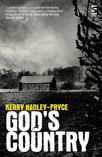Editing God's Country and Practice-Based-Research
- Kerry Hadley
- Jun 23, 2021
- 4 min read

I've been wandering, 'urbexing', or 'urban exploring' in a disused factory in Brierley Hill, just outside Dudley. I don't know what this factory used to make - because it inevitably made something, now it's derelict, probably built sometime int he 1960s, maybe later. There isn't any glass in the window, and nature, as nature does, is taking over the place, which sits within a council housing estate, near a chippy and a car mechanic's workshop. You have to climb through a fence and over a wall, but it's accessible, and I'm certainly not the first to go there. Someone wrote this and spray-painted it on the wall. It's a mix of standard English and phonetic, Black Country dialect, and it's a kind of love-song to the region. Sad, in a way, the content: 'We'm tuned in to the detuned spaces, like moths to a flame, but the flame ay theya.' It was timely for me, going there, because I'd attended a launch of an anthology, 'Practices of Placemaking: Affect, Antagonism, Attachment' and was glad that I could catch up with it again on youtube: https://www.youtube.com/watch?v=8rllr5glRJQ I liked the way the speakers referred to 'Deep hanging out' and 'reattaching people to place', and the way the discussion included a mention of collective trauma, or civic trauma, and the way in Covid 19 has created a specific kind of trauma for us in relation to place. The sense that there was no contingency for the disaster that was to befall us, and that moments of collective trauma must be considered when we think about placemaking. Frances Whitehead, an artist, spoke about 'artists making the invisible visible', and I like that because it struck me that my own creative writing - 'God's Country' - is not just an 'example of psychogeographic flow in Black Country fiction', it's far more than that because it is creative writing as placemaking.
This led me to read Lyle Skaines (2018) paper Creative Practice as Research: Discourse on Methodology https://www.tandfonline.com/doi/pdf/10.1080/14682753.2017.1362175?needAccess=true in which they say 'Practice-led research focuses on the nature of creative practice leading to new knowledge of operational significance for that practice, in order to advice knowledge about or within practice.' (original italics) (2018, p. 85) and, 'Put simply, in practice-based-research (PBR) the creative act is an experiment (whether or not the work itself is deemed 'experimental') designed to answer a direct research question about art and the practice of it which would not otherwise be explored by other methods.' (2018, p. 86), and - and this, I think is really what I'm doing - 'What emerges, then, from this methodology, is the exegesis that accompanies the creative work: that knowledge that has remained within the artist, made explicit and seated within the context of the scholarly field.' (2018, p. 86).

Exploring this factory was a psychogeographic act, but it was also a method of research - it was psychogeographic flow in action, yes, but it was also creative research - because by immersing myself in the place, the remains of the place, the place that was made as one thing, and for one purpose, and has been left, yet remains as a different place now, with a different meaning and purpose, I realised that my editing of 'God's Country', which today focused on Guy's return to the Black Country does a similar thing. Alison watches him and 'She'll tell how she saw him standing outside the farm, his feet planted, as if he was addressing the place, as if he was preparing to reattach himself.' Here, in writing about Guy's return, it is through the eyes of Alison - effectively an outsider - who sees the way the return to the Black Country affects him. This reminded me of the way in which artist Frances Whitehead referred to Vanessa Watts ideas about 'Place Thought'. She said, 'Place Thought means the place thinks, therefore I can think' and there is a revelatory feeling about that, and how the nature of place reveals itself, in this case, through my method of creative writing, and the way Place Thought revealed itself to me in my exploration of the empty factory.
I have read a lot about and have written about what Tim Edensor has to say about Industrial Ruins, and Maria Tumarkin's 'Traumascapes', which, I am aware of more and more in my editing of the novel, but those ideas are just that: ideas, until the physical act of wandering and exploring seems to ignite the link because what the Black Country is about now is the unintended, uncatered-for consequences of industrialisation, and this factory here represents the pre-post-industrialisation of the place which exists not just in the way of architecture, but of attitude and culture. Known as the 'cradle of the industrial revolution' the Black Country seethes with resentment because of the betrayal (felt in the actual air of the place, still) by the promise of the industrial revolution, unfulfilled. Here, in my creative piee, I am using creative writing as a form of research, or of conveying research, answering questions in the same way that Lyle Skains (2018) suggests that musicians do, where 'the creative artefact is consdered the embodiment of the new knowledge; emphasis is placed on creative exploration and innovation in the given artistic practice.' (2018, p. 85.) In Rob Clayton's film 'Estate',https://www.robclayton.co.uk/Estate-Film/1 Jonathan Meades says his filming and his photographs of the Lion Farm Estate in Oldbury deliberately aim to not make the place seem heroic, resisting drama and melodrama. I know I'm doing the same. I'm not trying to romanticise the place, or shame it either. That's not what this is about. The more I edit, I'm hoping, the clearer that will become.









Comments